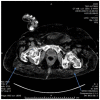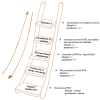Intradialytic Nutrition and Hemodialysis Prescriptions: A Personalized Stepwise Approach
- PMID: 32188148
- PMCID: PMC7146606
- DOI: 10.3390/nu12030785
Intradialytic Nutrition and Hemodialysis Prescriptions: A Personalized Stepwise Approach
Abstract
Dialysis and nutrition are two sides of the same coin-dialysis depurates metabolic waste that is typically produced by food intake. Hence, dietetic restrictions are commonly imposed in order to limit potassium and phosphate and avoid fluid overload. Conversely, malnutrition is a major challenge and, albeit to differing degrees, all nutritional markers are associated with survival. Dialysis-related malnutrition has a multifactorial origin related to uremic syndrome and comorbidities but also to dialysis treatment. Both an insufficient dialysis dose and excessive removal are contributing factors. It is thus not surprising that dialysis alone, without proper nutritional management, often fails to be effective in combatting malnutrition. While composite indexes can be used to identify patients with poor prognosis, none is fully satisfactory, and the definitions of malnutrition and protein energy wasting are still controversial. Furthermore, most nutritional markers and interventions were assessed in hemodialysis patients, while hemodiafiltration and peritoneal dialysis have been less extensively studied. The significant loss of albumin in these two dialysis modalities makes it extremely difficult to interpret common markers and scores. Despite these problems, hemodialysis sessions represent a valuable opportunity to monitor nutritional status and prescribe nutritional interventions, and several approaches have been tried. In this concept paper, we review the current evidence on intradialytic nutrition and propose an algorithm for adapting nutritional interventions to individual patients.
Keywords: Kt/V; MIS index; albumin; comorbidity; dialysis efficiency; elderly; hemodiafiltration; hemodialysis; malnutrition.
Conflict of interest statement
None regarding the present concept paper.
Figures




Similar articles
-
Efficiency and nutritional parameters in an elderly high risk population on hemodialysis and hemodiafiltration in Italy and France: different treatments with similar names?BMC Nephrol. 2018 Jul 9;19(1):171. doi: 10.1186/s12882-018-0948-8. BMC Nephrol. 2018. PMID: 29986663 Free PMC article.
-
Intradialytic parenteral nutrition in maintenance hemodialysis patients suffering from protein-energy wasting. Results of a multicenter, open, prospective, randomized trial.Clin Nutr. 2017 Feb;36(1):107-117. doi: 10.1016/j.clnu.2015.11.016. Epub 2015 Dec 12. Clin Nutr. 2017. PMID: 26708726 Clinical Trial.
-
Use of Intradialytic Parenteral Nutrition in Patients Undergoing Hemodialysis.Nutr Clin Pract. 2018 Dec;33(6):767-771. doi: 10.1002/ncp.10190. Epub 2018 Sep 12. Nutr Clin Pract. 2018. PMID: 30207411 Review.
-
Prescribing Hemodialysis or Hemodiafiltration: When One Size Does Not Fit All the Proposal of a Personalized Approach Based on Comorbidity and Nutritional Status.J Clin Med. 2018 Oct 8;7(10):331. doi: 10.3390/jcm7100331. J Clin Med. 2018. PMID: 30297628 Free PMC article.
-
[Nutrition and dialysis: how to keep adequate nutrition in dialysis?].Rev Med Suisse Romande. 2004 Nov;124(11):681-8. Rev Med Suisse Romande. 2004. PMID: 15631165 Review. French.
Cited by
-
Incremental and Personalized Hemodialysis Start: A New Standard of Care.Kidney Int Rep. 2022 Feb 19;7(5):1049-1061. doi: 10.1016/j.ekir.2022.02.010. eCollection 2022 May. Kidney Int Rep. 2022. PMID: 35571001 Free PMC article.
-
Progress in the study of nutritional status and selenium in dialysis patients.Ann Med. 2023 Dec;55(1):2197296. doi: 10.1080/07853890.2023.2197296. Ann Med. 2023. PMID: 37038353 Free PMC article. Review.
-
Comparison of the prevalence and associated factors of cognitive frailty between elderly and middle-young patients receiving maintenance hemodialysis.Int Urol Nephrol. 2022 Oct;54(10):2703-2711. doi: 10.1007/s11255-022-03188-3. Epub 2022 Apr 2. Int Urol Nephrol. 2022. PMID: 35366144 Free PMC article.
-
Hemodialysis-Nutritional Flaws in Diagnosis and Prescriptions. Could Amino Acid Losses be the Sharpest "Sword of Damocles"?Nutrients. 2020 Jun 14;12(6):1773. doi: 10.3390/nu12061773. Nutrients. 2020. PMID: 32545868 Free PMC article. Review.
-
Consensus on the standard terminology used in the nutrition care of adult patients with chronic kidney disease.J Bras Nefrol. 2021 Apr-Jun;43(2):236-253. doi: 10.1590/2175-8239-JBN-2020-0210. J Bras Nefrol. 2021. PMID: 33836040 Free PMC article.
References
-
- Piccoli G.B., Moio M.R., Fois A., Sofronie A., Gendrot L., Cabiddu G., D’Alessandro C., Cupisti A. The Diet and Hemodialysis Dyad: Three Eras, Four Open Questions and Four Paradoxes. A Narrative Review, Towards a Personalized, Patient-Centered Approach. Nutrients. 2017;9:372. doi: 10.3390/nu9040372. - DOI - PMC - PubMed

